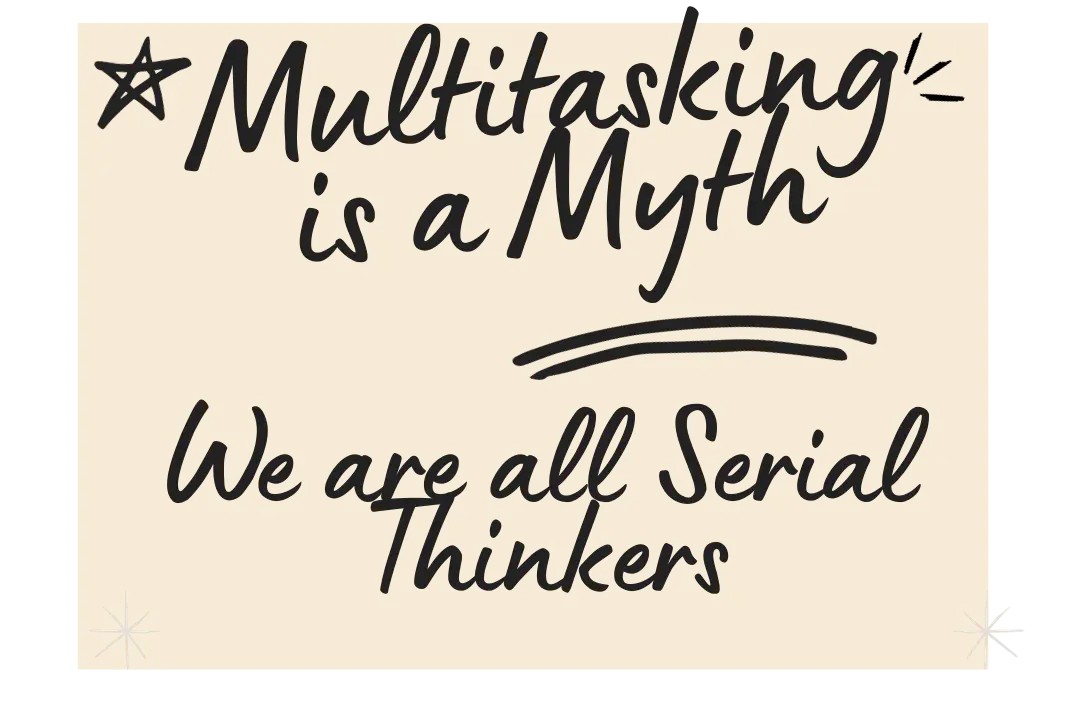The Price of Multitasking
In the age of information overload and the constant demands of modern life, multitasking has become commonplace. People often find themselves juggling various tasks, switching between work assignments, checking smartphones, and attending to personal matters simultaneously. While multitasking may seem like an efficient way to manage multiple responsibilities, it comes with a hidden cost known as the “cognitive switching penalty.”
What is the cognitive switching penalty? Why does it occur and how does it impact our productivity?
Understanding Cognitive Switching
Cognitive switching, or task switching, (what we commonly refer to as multitasking) refers to the process of shifting one’s attention, focus, and cognitive resources from one task to another. When you interrupt the current task and start or resume another task, that’s cognitive switching. The interruptions can be external (e.g., receiving a phone call) or self-initiated (e.g., checking social media while working). Cognitive switching can happen rapidly and frequently, often without individuals even realizing it.
The Cognitive Switching Penalty
The cognitive switching penalty is the price people pay for task switching. Here are are few of the factors:
Time Loss: When you switch from one task to another, it takes time to disengage from the initial task, reorient to the new one, and get back up to full productivity. This transition period, referred to as “switching time,” results in a loss of time and efficiency.
Reduced Productivity: The act of switching between tasks often leads to decreased productivity for both the interrupted task and the new task. People are less efficient and effective in completing each task, which can have a cumulative negative effect on overall productivity.
Increased Errors: Cognitive switching can lead to an increase in errors and mistakes. When you resume a task after switching, you may lose your place, forget important details, or misinterpret information, which can be a big problem in complex or high-stakes tasks.
Mental Fatigue: Frequent task switching can lead to mental fatigue and reduced cognitive resources. This fatigue can accumulate over time and negatively impact decision-making, problem-solving, and creative thinking.
Stress and Frustration: Task switching can lead to increased stress and frustration. Constantly shifting attention from one task to another can disrupt a sense of flow and well-being.
Why Cognitive Switching Occurs
There are lots of reasons cognitive switching occurs:
Technological Distractions: The ever present smartphones, social media, and instant messaging makes it easier to fall victim to distractions and task switching.
Overload: When individuals feel overwhelmed by a high volume of tasks or information, they may resort to task switching as a coping mechanism.
Lack of Focus: Difficulty in maintaining sustained attention on a single task can lead to frequent cognitive switching.
Perceived Urgency: The belief that certain tasks are more urgent or important can prompt individuals to switch tasks.
Boredom: Monotonous or repetitive tasks can lead to task switching as people seek novelty or diversion.
Minimizing the Cognitive Switching Penalty
While it’s impossible to eliminate all cognitive switching in today’s fast-paced world, there are strategies to minimize its negative effects:
Prioritize Tasks: Identify high-priority tasks and allocate focused time for them, minimizing unnecessary task switching.
Set Boundaries: Establish specific times for checking emails, social media, or other potential distractions to reduce the frequency of switching.
Time Blocking: Use time-blocking techniques to allocate dedicated time for specific tasks, ensuring minimal interruptions during those periods.
Self-Awareness: Being self-aware can help you recognize when task switching is counterproductive and allow you to consciously choose to stay on task.
Single-Tasking: Embrace the practice of single-tasking, devoting full attention to one task at a time to maximize productivity and reduce cognitive switching.
Limit Notifications: Reduce unnecessary notifications on your devices to minimize external distractions. Silence your mobile phone and disable the notifications “ding” on your desktop.
Take Breaks: Incorporate short, planned breaks to refresh and recharge your cognitive resources.
The human brain has limits when it comes to multitasking. In reality, you aren’t multitasking at all. You are going from one task to another serially and definitely not doing more than one thing at a time. The cognitive switching penalty is the price you pay for attempting multitasking.
Multitasking may appear advantageous in certain situations but you should factor in the cost of cognitive switching.
In reality, you will be more productive when you reduce your tendency to try to do multiple things at the same time.
Implementing the strategies above, will reduce the frequency of task switching and as a result, reduce the penalty you pay for cognitive switching.
Try it, you can thank me later.

